Located in Africa and Asia, lions (Panthera leo) are mighty, aggressive creatures. Lions are of the order Carnivora, of the family Felidae, and the genus Panthera. “Panthera” is a name of Greek origin and includes various large cat species like tigers, lions, jaguars, and leopards. These animals, including lions, can all roar.
Lions prey on smaller animals like antelopes, warthogs, and zebras and inhabit open woodland, scrub, and grassland. They live in small groups called prides, and their biggest threat is habitat loss. They’re often brown, gold, tawny, or blonde in color and range between 264 pounds to 550 pounds in weight and 4.7 feet to 8.2 feet in length.
One commonly known fact about lions is that they can roar. In truth, you can hear a lion’s roar from up to five miles away. But why do they do this? There are various explanations for a roaring lion, from establishing his dominance to attracting a mate. Here are ten specific reasons why lions roar.
1. Communicating With Their Pride
Lions will roar to communicate with members of their pride. It’s a common way for them to keep in touch with each other, especially if they’re separated throughout the day. Each lion has its unique call, which helps other lions identify the location of the particular lion.
Roaring can be done for various purposes, such as telling them about a food source, warning them of danger, or simply attempting to bond with them. In fact, within a pride, lions are strongly bonded to one another. They communicate in other ways besides roaring, including licking each other, rubbing heads, nuzzling, and different vocalizations.

A lion’s roar can be heard from miles away and is often a way to communicate with other lions.
©AB Photography/iStock via Getty Images
2. Establishing Their Dominance
Lions roar to establish their dominance among others in their pride. Because lion prides have a hierarchy, male lions typically fight each other for dominance. Some will even attempt to take over other prides. When this happens, the existing leader of that pride will work to protect their members and sustain their place at the top.
Roaring is a major way lions express dominance. Lions decide who is boss by roaring, flaring, mounting, and fighting. These aggressive behaviors serve them well in their fight for the top of the hierarchy.

Lions are the only cat species that roar together as a pride.
©Holly S Cannon/Shutterstock.com
3. Defending Their Territory
Just as they defend their pride, lions defend their territory. This typically involves marking the area with urine, rubbing their muzzle against the grass or shrubs, and raking the ground with their paws to leave behind their scents.
Still, sometimes predators or other animals will continue to pursue the lion’s territory despite these warnings. When this happens, the male lion will roar ferociously to scare off the intruders and remind them who’s in charge. This reduces the likelihood of or need for any territorial disputes. However, should a predator put up a fight, the lion will do what it can to defend its area and pride.
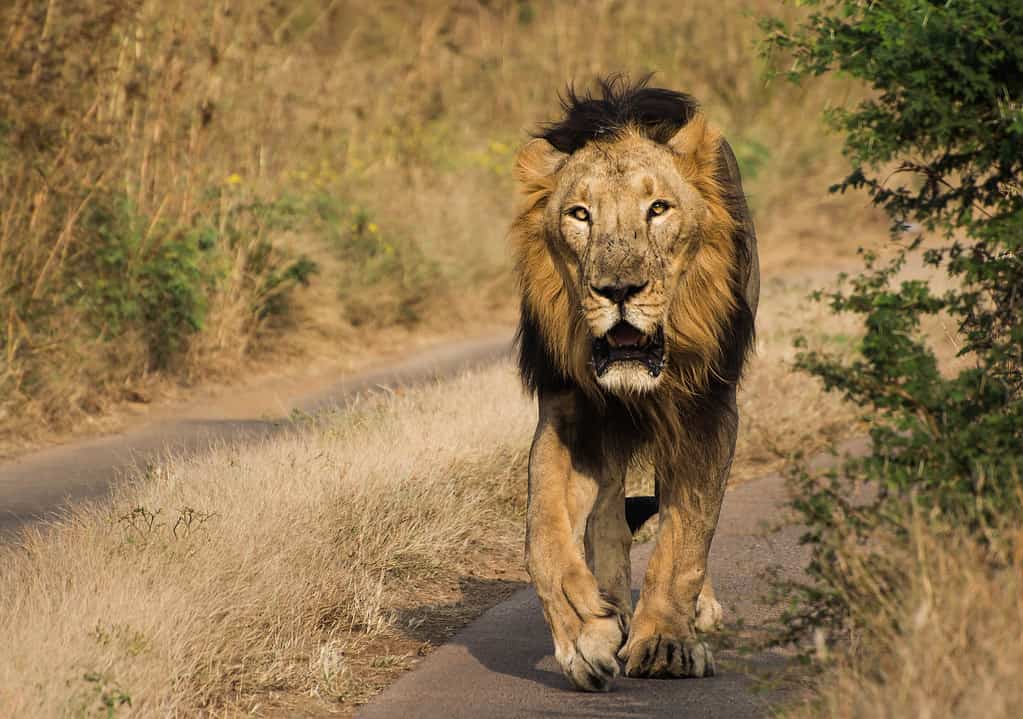
Dominant male lions typically have louder, more ferocious roars than less dominant or female lions.
©ibrandcare/iStock via Getty Images
4. Reinforcing Social Bonds
Just as humans communicate with one another, lions do the same. Roaring is often a way for them to reinforce their social bonds. Sometimes, roaring as a pride encourages deeper bonds and strengthens their connections. Even cubs will often join in once they develop the ability to roar. They typically can roar by the age of two or three months — though they might not be able to reach the same ferociousness or volume as adult lions.

Lions are a quite sociable cat species — the only one to live in groups.
©LYNCHPIN254/Shutterstock.com
5. Attracting Mates
Roaring showcases a male lion’s dominance, often attracting female lions for mating. Subconsciously, this communicates the ability to protect their pride, including the lioness and lion cubs. Lions typically use their roars as a courtship display. The behavior helps alert nearby female lions of their presence and eagerness to mate.
Additionally, sometimes, male lions must compete with other lions for a potential mating partner. To compete, they’ll communicate their dominance by aggressively roaring at their competitor.
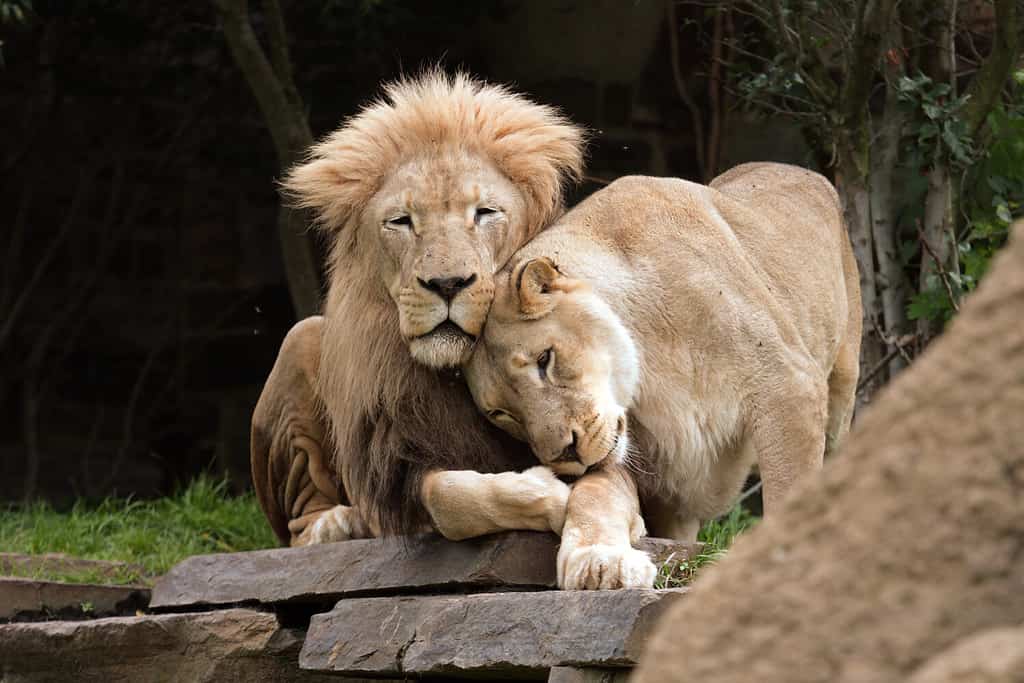
The male lion is larger than the female lion, but the females in a pride are the hunters.
©Wicker Imaging/Shutterstock.com
6. Expressing Their Power
As mentioned above, lions roar to express their power. This is done in a variety of settings and for a variety of reasons. For example, a lion will typically express its power to other lion prides who might be competing for prey. They also will roar to show potential threats or predators that they’re willing to put up a good fight. The roar will often scare off intruders and deter other animals from attempting to attack young cubs or vulnerable members of the pride.
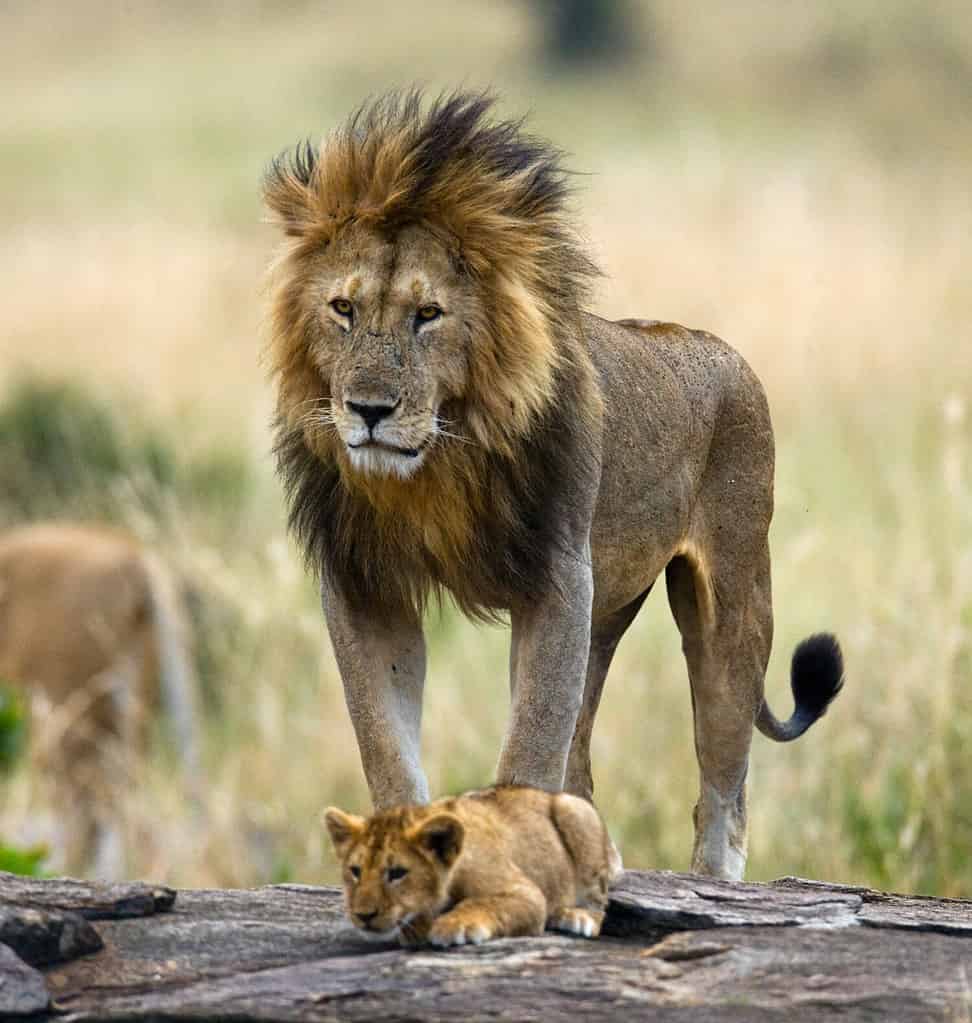
Male lions often protect their cubs while the female is hunting for food.
©GUDKOV ANDREY/Shutterstock.com
7. Coordinating an Attack
Both male and female lions roar — and often for the same reasons. However, a male lion’s roar is typically deeper and more deafening than a lioness’s vocal call. Since lionesses generally are responsible for hunting prey and feeding their cubs, they often use their roar to announce feeding times. Additionally, lionesses usually hunt in groups, and roaring is a common way to communicate with the other lions when coordinating or executing an attack.
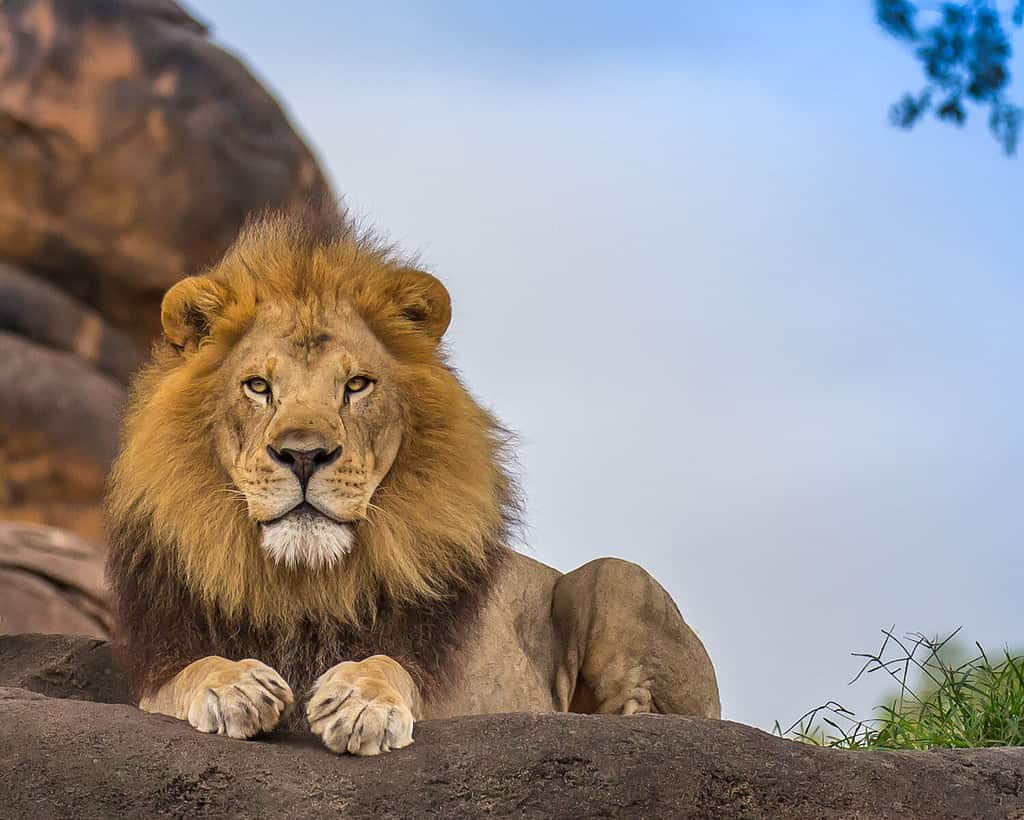
A large male lion can weigh up to 550 pounds!
©Jrossphoto/Shutterstock.com
8. Warning Pride of Danger
If a lion or lioness senses danger, they will use their roar to warn the rest of their pride. While lions have few predators, some sick or young lions can be vulnerable to attacks — especially by hyenas or human hunters. Additionally, lions often attack and kill each other for various reasons. Whenever a lion senses any threat, it will roar as if to tell its pride to seek protection.
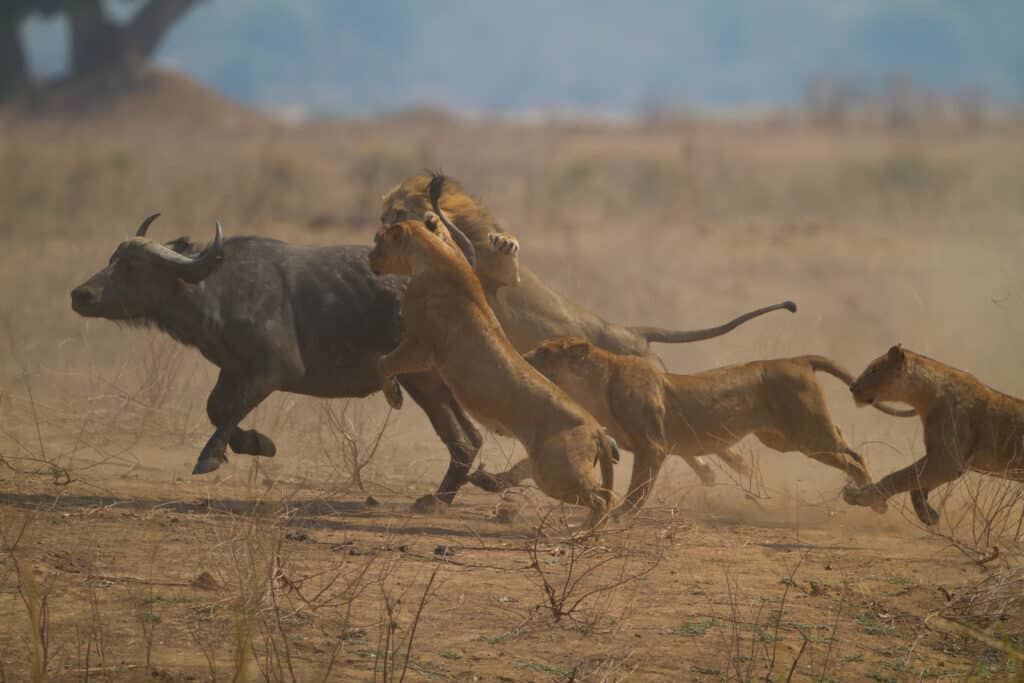
Lions will often work together to attack larger prey like
buffalo
.
©Jez Bennett/Shutterstock.com
9. Using Echolocation
Echolocation involves using sound’s reflection to determine a territory’s size and boundaries. For example, a lion will often roar into an open space to hear its echo off nearby objects and better understand its surroundings. A lion’s roar is so mighty it can be heard from miles away. The thunderous sound can help the lion gauge the size and limits of its territory.

Lions won’t eat other predators like cheetahs, leopards, and hyenas.
©Maryke Scheun/Shutterstock.com
10. Relieving Stress
Lions often roar to respond to stress (like in the above). For example, if a lion feels threatened, he will likely roar. If a lion needs to establish his dominance, he will likely roar. If a lion is protecting his pride or territory, he will likely — you guessed it — roar. These high-stress situations cause the lion to become vocal and make his power known, and roaring can relieve stress.
There’s a specific movement in yoga called lion’s breath. Yoga involves stretching your facial muscles to ease tension, improve circulation, and eliminate toxins. You then stick your tongue out while exhaling a long, deep breath. The exhale can act as a sigh of relief.
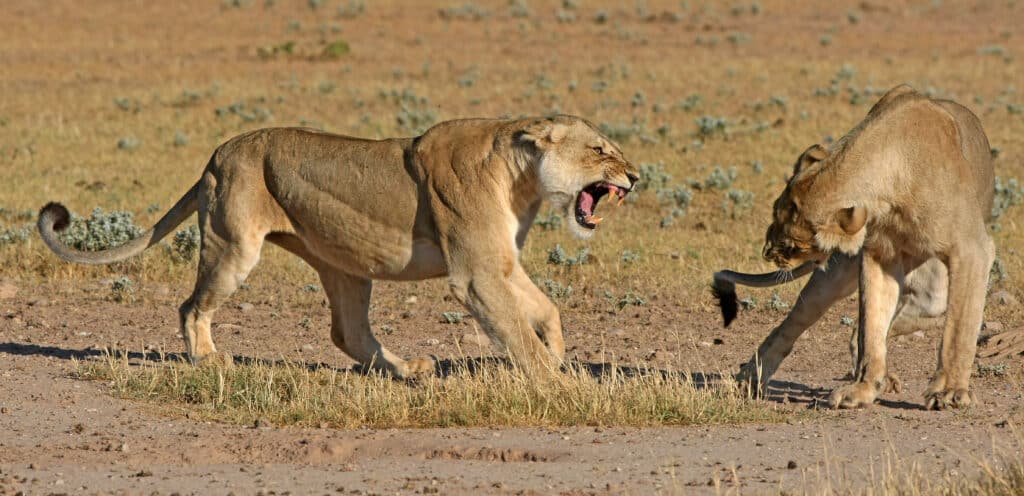
Roaring can help lions alert their pride of danger while establishing their dominance.
©Seyms Brugger/Shutterstock.com
The photo featured at the top of this post is © Henrico Muller/Shutterstock.com
Thank you for reading! Have some feedback for us? Contact the AZ Animals editorial team.






